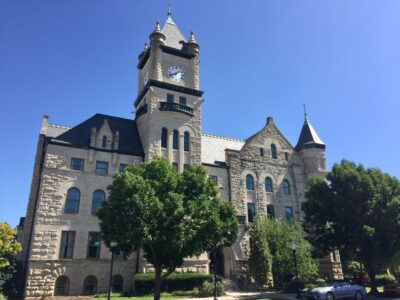Lawrence Community Shelter’s executive director says he’s seen positive changes, improved culture in his first year

photo by: Austin Hornbostel/Journal-World
James Chiselom, the new executive director at the Lawrence Community Shelter, is pictured Monday, Jan. 8, 2024.
The Lawrence Community Shelter has served more people this year than it did last year, and its executive director is hoping that the positive changes undertaken during that time will allow for more options and opportunities to support the unhoused population.
James Chiselom, the executive director of the LCS, said that as of Tuesday the shelter has assisted a total of 607 different people in 2024, and he said he is expecting it will serve more before the end of the year. Last year, the shelter across all of its operations served 594 people.
Chiselom, who began working as the executive director in January, said that over the past year there has been an increase in the unhoused population. As the Journal-World reported, the point-in-time count in Douglas County, a survey mandated by the U.S. Department of Housing and Urban Development, found 414 people were experiencing homelessness in the county on the night of the count in January — a number 18% higher than on the night of the count in January 2023.
When he started at the LCS in January, Chiselom felt it was an “eye-opening time” for him and a chance to make improvements to some key parts of the shelter to make it better for the people it served.
In an effort to make the space more welcoming, Chiselom said the shelter was deep-cleaned and renovated with a new paint job to help provide more comfort and dignity to guests. Along with the cosmetic changes, Chiselom said he felt a need to add more structure and consistency in terms of policies at the shelter.
When he came in last year in the middle of extreme weather situations, it sometimes seemed that the shelter was operating in “crisis mode.” After stabilizing the situation, Chiselom said the team worked to create new procedures for staff to follow and new expectations for guests’ behavior while at the shelter, which resulted in less chaos at the shelter.
Those initiatives — new policies and procedures, a more structured environment and renovations — were things that helped improve conditions at the LCS.
“Those are the biggest three things I think we’ve done in the last year to make it more amenable (for people) to come in,” Chiselom said.
Another success from this year came from an increase in staff and a better environment for the workers, Chiselom said. Chiselom hired a new deputy director, Kim Brabits, in March, and she added more training for the staff with her background in social work.
Additionally, the approval of a union contract for the LCS staff, which happened in April, helped employees feel “more comfortable” and secure in their jobs, Chiselom said. Those improved conditions for his “passionate” staff at the shelter have led to better first impressions for its guests and have made the culture more welcoming, Chiselom said.
“We want people to see a smile and hear someone asking ‘What do you need?’ and mean it,” Chiselom said.
This year, the shelter also expanded its food services and is now serving three hot meals per day. Chiselom said LCS was able to hire a chef in March and started the program with almost nothing before that. Despite initially barely piecing the program together, the nonprofit now provides 425 meals each day for the guests in its main shelter building and the Village — another improvement that’s happened this year.
“It’s big (to have) the ability to feed people nutritious meals that people want,” Chiselom said.
As the shelter prepares for next year, it’s facing a problem similar to what other nonprofits are experiencing: a decrease in donations. According to LCS data, the shelter received $66,500 less from individual donors this year than it budgeted for, and while an increase in in-kind donations softened the blow somewhat, it still has just over $61,000 less in total donations than it budgeted for.
Chiselom said donations are down nationally, because people are holding onto more of their money as cost of living has gone up and COVID-era government stimulus programs have gone away. Only about 4% of LCS’ funding comes from donations; the majority of its funding comes from the City of Lawrence, 83.6%, and Douglas County, 10.3%. Chiselom said when people see that, their reaction might be to not donate again because of the large amounts of government support.
But with the resources the shelter has, Chiselom hopes to continue to expand and help the unhoused in Lawrence. The shelter is planning to add 24 more Pallet shelters behind its main building, which will increase its capacity by 50 people as the Journal-World reported. Chiselom said the LCS is working to find solutions to ensure people who find themselves unhoused can get the support they need.
“The longer someone stays unhoused, the harder it is to get them housed again,” Chiselom said. “The quicker we can get someone back into permanent housing, the better.”







